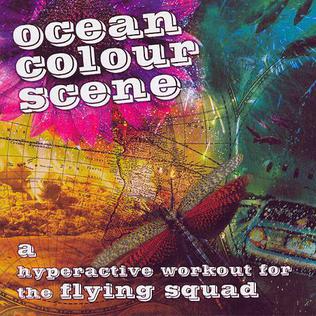
Attention deficit hyperactivity disorder (ADHD) is a neurodevelopmental disorder characterized by executive dysfunction occasioning symptoms of inattention, hyperactivity, impulsivity and emotional dysregulation that are excessive and pervasive, impairing in multiple contexts, and developmentally-inappropriate.

Methylphenidate, sold under the brand names Ritalin and Concerta among others, is a central nervous system (CNS) stimulant used medically to treat attention deficit hyperactivity disorder (ADHD) and, to a lesser extent, narcolepsy. It is a primary medication for ADHD ; it may be taken by mouth or applied to the skin, and different formulations have varying durations of effect. For ADHD, the effectiveness of methylphenidate is comparable to atomoxetine but modestly lower than amphetamines, alleviating the executive functioning deficits of sustained attention, inhibition, working memory, reaction time and emotional self-regulation.
ADD is short for attention deficit disorder, and is an older name for attention deficit hyperactivity disorder.

Atomoxetine, sold under the brand name Strattera, is a selective norepinephrine reuptake inhibitor medication used to treat attention deficit hyperactivity disorder (ADHD) and, to a lesser extent, cognitive disengagement syndrome. It may be used alone or along with psychostimulants. It enhances the executive functions of self-motivation, sustained attention, inhibition, working memory, reaction time and emotional self-regulation. Use of atomoxetine is only recommended for those who are at least six years old. It is taken orally. The effectiveness of atomoxetine is comparable to the commonly prescribed stimulant medication methylphenidate.

Dexmethylphenidate, sold under the brand name Focalin among others, is a potent central nervous system (CNS) stimulant used to treat attention deficit hyperactivity disorder (ADHD) in those over the age of five years. It is taken by mouth. The immediate release formulation lasts up to five hours while the extended release formulation lasts up to twelve hours. It is the more active enantiomer of methylphenidate.
Adult Attention Deficit Hyperactivity Disorder is the persistence of attention deficit hyperactivity disorder (ADHD) into adulthood. It is a neurodevelopmental disorder, meaning impairing symptoms must have been present in childhood, except for when ADHD occurs after traumatic brain injury. Specifically, multiple symptoms must be present before the age of 12, according to DSM-5 diagnostic criteria. The cutoff age of 12 is a change from the previous requirement of symptom onset, which was before the age of 7 in the DSM-IV. This was done to add flexibility in the diagnosis of adults. ADHD was previously thought to be a childhood disorder that improved with age, but recent research has disproved this. Approximately two-thirds of childhood cases of ADHD continue into adulthood, with varying degrees of symptom severity that change over time and continue to affect individuals with symptoms ranging from minor inconveniences to impairments in daily functioning.
Cognitive disengagement syndrome (CDS) is a syndrome characterized by developmentally-inappropriate, impairing and persistent levels of decoupled attentional processing from the ongoing external context and resultant hypoactivity. Symptoms often manifest in difficulties with staring, mind blanking, withdrawal, mental confusion and maladaptive mind wandering alongside delayed, sedentary or slow motor movements. To scientists in the field, it has reached the threshold of evidence and recognition as a distinct syndrome.
Neurodevelopmental disorders are a group of mental conditions affecting the development of the nervous system, which includes the brain and spinal cord. According to the American Psychiatric Association Diagnostic and Statistical Manual of Mental Disorders, Fifth Edition, (DSM-5) published in 2013, these conditions generally appear in early childhood, usually before children start school, and can persist into adulthood. The key characteristic of all these disorders is that they negatively impact a person's functioning in one or more domains of life depending on the disorder and deficits it has caused. All of these disorders and their levels of impairment exist on a spectrum, and affected individuals can experience varying degrees of symptoms and deficits, despite having the same diagnosis.
Attention deficit hyperactivity disorder predominantly inattentive, is one of the three presentations of attention deficit hyperactivity disorder (ADHD). In 1987–1994, there were no subtypes or presentations and thus it was not distinguished from hyperactive ADHD in the Diagnostic and Statistical Manual (DSM-III-R). In DSM-5, subtypes were discarded and reclassified as presentations of the same disorder that change over time.

A Hyperactive Workout for the Flying Squad is the seventh studio album by English rock band Ocean Colour Scene. It was originally due to be released in September 2004 but Sanctuary Records requested the band record a live album instead and it was eventually released on 21 March 2005. The album was produced by Dave Eringa and recorded at a hunting lodge near Kirriemuir, Scotland. The album's unusual title was a phrase the band heard on BBC Radio 4 and decided they liked. Critical reception to the album generally agreed that the album would please Ocean Colour Scene fans, although the album charted lower than previous albums at number 30 in the UK album chart compared to number 14 for the previous album North Atlantic Drift.

Mortein is an Australian brand of household insecticide owned by the British company Reckitt. Together with its sister product Aerogard, a popular insect repellent, Mortein is widely used in Australia and is marketed internationally. It is also available in New Zealand, India, Pakistan, Fiji, and the Comoros. The brand has been represented in television commercials by cartoon antagonist Louie the Fly.

Lasse Gjertsen is a Norwegian animator, musician, and videographer. He is best known for his short pieces "Hyperactive" and "Amateur", big hits in the early years of YouTube, which strung together short clips of video to create a unique form of video akin to stop-motion animation. His "Hyperactive" video has over 8.9 million views and his "Amateur" video has over 16 million views.
Attention is the mental process involved in attending to other objects.

Mark Alan Lowry is an American singer, comedian, minister and songwriter. He is best known for co-writing the song "Mary, Did You Know?" and being a member of the Gaither Vocal Band from 1988 to 2001, and 2009 to 2013, along with Michael English, Guy Penrod, David Phelps and Bill Gaither. Lowry has recorded twelve albums, both music and comedy.

"Crying Blood" is the debut single by singer V V Brown. It was released on 3 November 2008 and was accompanied by a music video. The song did not chart as it was not eligible to do so. It was released as a limited release on Digital download and 7-inch vinyl. Brown wrote this song after finishing with her mean American boyfriend and returning to England. Despite its lyrical woe, the melody is upbeat. She explained to Q magazine: “That was an accident, actually. I simply wanted to give the impression, musically, that I was over him. It’s true he was terribly mean, but ultimately I’m an optimistic sort.”. This song is also featured on Just Dance 2 as a downloadable song. "Crying Blood" was the opening title song to the movie Lesbian Vampire Killers starring Mathew Horne and James Corden
Hyperkinesis may refer to:
A deficit is the amount by which a sum falls short of some reference amount.
Attention deficit hyperactivity disorder or ADHD is a neurodevelopmental disorder.

"Hyperactive" is a song by the English singer Robert Palmer, which was released in 1986 as the fourth single from his eighth studio album Riptide (1985). The song was written by Dennis Nelson, Tony Haynes and Palmer, and produced by Bernard Edwards. Released as the follow-up to his US chart topper "Addicted to Love", "Hyperactive" reached No. 33 on the Billboard Hot 100 and was the first time Palmer had scored two consecutive top 40 US hits from an album. It remained on the charts for twelve weeks.









